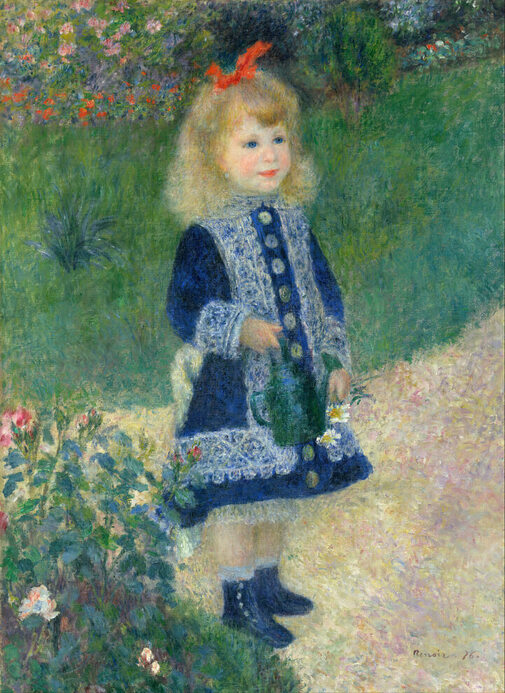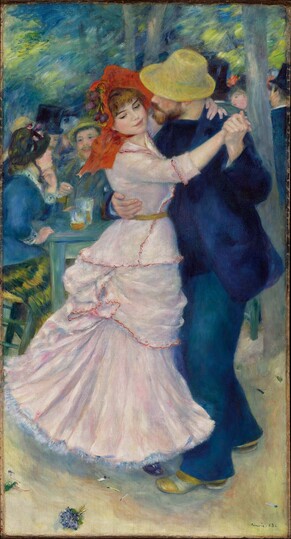|
Where? Gallery 85 of the National Gallery of Art
When? 1876 Commissioned by? Possibly for the art collection of Baron Achille Sellière What do you see? A young and pretty girl holds a green watering can in her right hand and two daisies in her left hand. She is probably around four years old and wears a knee-length, deep blue dress with extensive white lace on it. She also wears matching blue boots with white lace on the top. She has red lips, blue eyes, and rosy cheeks. She has a red bow in her long curly blonde hair. She seems to be content while watering the flowers. The girl stands on a light-colored footpath in the garden. The colors that Renoir used for the stones and dirt on the footpath contrast nicely with the green grass surrounding it. On the bottom left are a rose bush and some grass. In the background is more grass and a collection of flowers. In this painting, you can clearly see that Renoir applied the colors with individual touches and that he did not mix them on the canvas. This technique is typical of the Impressionist art style. No Shadow: Interestingly there is no shadow visible anywhere in this painting. The reason is that Renoir wanted to create an illuminating painting where the light radiates from the painting as soon as you see it. This painting is a good example of a painting that stands out from the rest of the paintings in the room in the National Gallery of Art. Another example of such an illuminating painting is Sunflowers by Van Gogh. You can see one of the versions of this painting in the Philadelphia Museum of Art and this painting also clearly stands out from the other paintings in the room. Another version is in the National Gallery in London. It is, however, also surprising that Renoir did not include a shadow in this painting, as he famously said: "No shadow is black. It always has a color. Nature knows only colors … white and black are not colors."
Backstory: According to some, this painting has been created in the garden of Claude Monet in Argenteuil, France, but this is not certain. The girl in this painting is probably a girl that lived near Renoir, possibly called Mademoiselle Leclere. He picked her because of her prettiness and especially her distinctive eyes.
This painting is a classical Impressionist painting as it focuses on the different colors and how they can be used to represent the effects of sunlight. Like many other Impressionist paintings, this work was painted while Renoir was outside (something that was uncommon in the period before Impressionism). However, at the same time, the simplicity of this painting is a first step in the direction of Post-Impressionism which is famous because of artists like Van Gogh. Who is Renoir? Pierre-Auguste Renoir (1841-1919) was a French impressionist painter. When he was three years old, his family moved to Paris and lived close to the Louvre. As a child, he often visited the Louvre to admire works of art. He developed himself into one of the best Impressionist painters and nowadays you can find some of his work in the Musée d'Orsay. Together with people like Manet, Monet, and Pissarro, he is one of the founders of the Impressionist art style. Renoir said that he painted for fun and painted scenes “which made me want to walk in it.” He continued to enjoy painting until the end of his life, even after he had developed arthritis and it became difficult to hold a brush. Some of his other great works include Dance at Bougival at the Museum of Fine Arts in Boston and La Promenade in the Getty Museum.
Fun fact: At the time of this painting, Renoir was still in a struggle for money. To generate money, Renoir decided to paint widely attractive scenes of women and children in the hope that these would sell more easily and possibly attract some commissions for portraits. These kind of scenes were in high demand in France at that time. His strategy paid off as by 1879 he had become a successful painter with some money which he used to travel around Europe and North Africa.
Interested in a copy for yourself? Poster or canvas.
Written by Eelco Kappe
References:
10 Comments
vicki
4/16/2020 12:38:53 pm
did the girl with watering can by renoir have a yellow ribbon ?i have this painting only she has a yellow ribbon
Reply
Eelco Kappe
4/17/2020 03:08:42 pm
Nice! Renoir painted only a single version of this painting and the girl in his painting has a red ribbon. So, I guess that you have a creative replica of the painting..
Reply
Matthew Burrow
5/5/2020 03:46:44 pm
I have this Exact painting and it was given to me by an older woman at passed away and I took it out of the frame and on the back it is hand written, National Gallery of Art, Chester Dale collection could this mean anything?
Reply
Eelco Kappe
5/6/2020 10:30:30 am
Hi Matthew,
Reply
Sue
12/30/2020 05:56:47 pm
Does anyone know where I could view the back side of this framed painting? I am researching the frame Akers for the French Impressionists, but unfortunately it’s very hard to find the back view of these paintings. Thank you.
Reply
Sue
12/30/2020 05:58:47 pm
*framemakers
Reply
Eelco Kappe
12/31/2020 07:34:06 am
Hi Sue,
John Becker
9/7/2022 07:07:02 pm
Found a copy of this painting in old attic with hand written girl with watering can #139. How valuable?
Reply
1/18/2023 04:24:20 pm
Thanks for sharing this post, it is very helpful article.
Reply
7/19/2023 05:28:03 am
I definitely enjoyed every bit of it and I have you bookmarked your blog to check out the new stuff you post in the future.
Reply
Leave a Reply. |
Categories
All
|
- Home
- Blog
-
Museums
- Alte Pinakothek
- Art Institute of Chicago
- Baltimore Museum of Art
- Barber Institute of Fine Arts
- Bargello
- Barnes Foundation
- British Museum
- Church of Sant’Anastasia
- Cleveland Museum of Art
- Courtauld Institute of Art
- Detroit Institute of Arts
- Frans Hals Museum
- Galleria Borghese
- Gallerie dell'Accademia
- Getty Museum
- Guggenheim
- Hermitage Museum
- Kunsthistorisches Museum
- Kunstmuseum Basel
- Legion of Honor Museum
- Louvre
- Mauritshuis
- Metropolitan Museum of Art
- Musee d’Orsay
- Museum of Fine Arts in Boston
- Museum of Modern Art
- National Gallery in London
- National Gallery of Art
- National Museum in Poznań
- Norton Simon Museum
- Ny Carlsberg Glyptotek
- Palace of Versailles
- Palazzo Pitti
- Palazzo Vecchio
- Petit Palais
- Philadelphia Museum of Art
- Prado
- Pushkin Museum
- Ravenna Art Museum
- Rijksmuseum
- San Diego Museum of Art
- Santa Maria delle Grazie
- St. Peter's Basilica
- Städel Museum
- Statens Museum for Kunst
- Tate Britain
- Tate Modern
- Timken Museum of Art
- Uffizi
- Vatican Museums
- Wallace Collection
-
Artists
- Altdorfer
- Anguissola
- Berlin Painter
- Bosch
- Botticelli
- Boucher
- Bronzino
- Bruegel the Elder
- Brunelleschi
- Cabanel
- Caillebotte
- Canova
- Caravaggio
- Carpeaux
- Cezanne
- Cimabue
- David
- Degas
- Delacroix
- De Maria
- Donatello
- El Greco
- Fontana
- Fra Angelico
- Fragonard
- Gauguin
- Gentileschi
- Gericault
- Gonzalez-Torres
- Goya
- Hals
- Hogarth
- Hokusai
- Ingres
- Leonardo da Vinci
- Lippi, Filippo
- Longhi, Barbara
- Lorrain
- Makovsky
- Manet
- Massys
- Matisse
- Merian
- Michelangelo
- Mochi
- Modigliani
- Monet
- Panini
- Parmigianino
- Perugino
- Picasso
- Pisanello
- Raphael
- Rembrandt
- Renoir
- Reynolds
- Rivera
- Rodin
- Rubens
- Scultori
- Seurat
- Steen
- Tintoretto
- Titian
- Toulouse-Lautrec
- Turner
- Uccello
- Van der Weyden
- Van Dyck
- Van Eyck
- Van Gogh
- Van Hemessen
- Vasari
- Velazquez
- Vermeer
- Veronese
- Vigée Le Brun
-
Locations
- Books
- About Us




